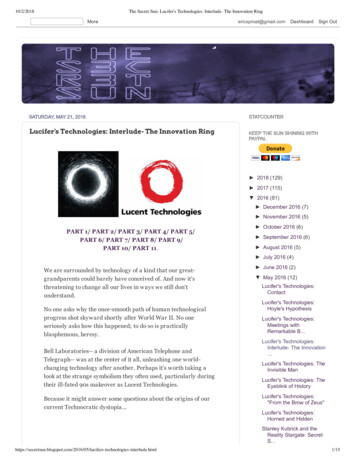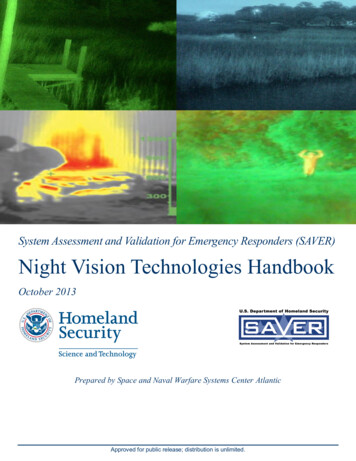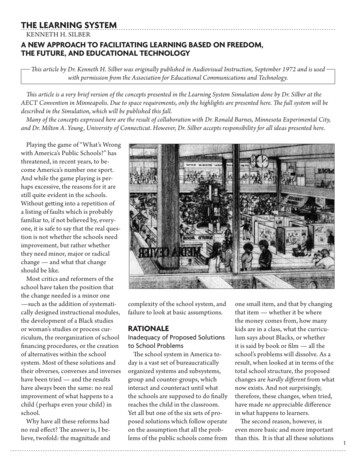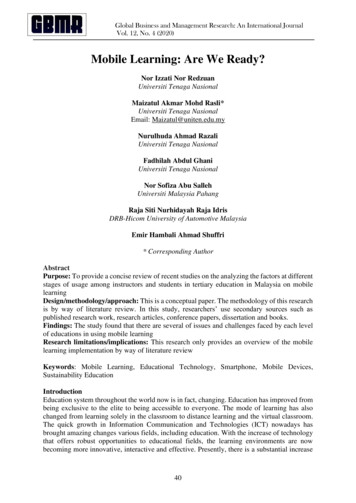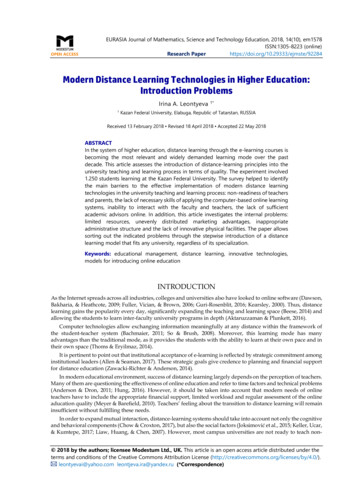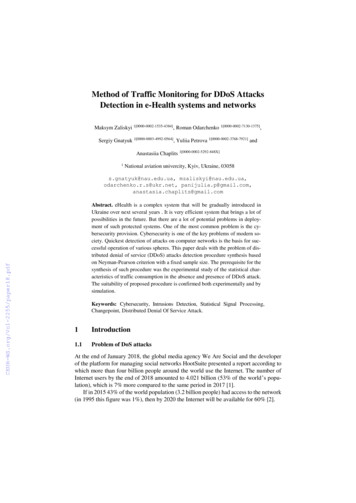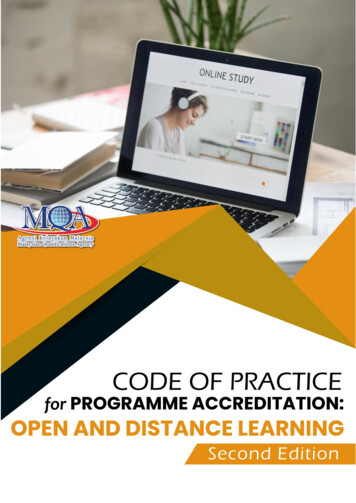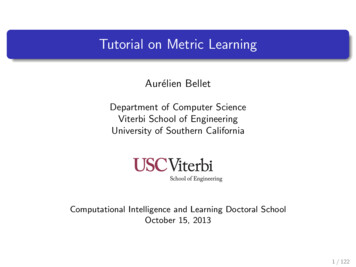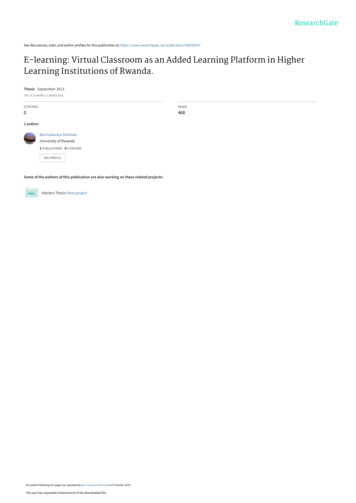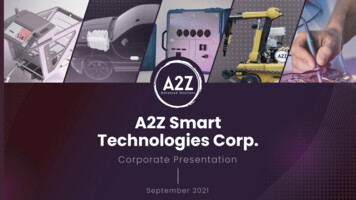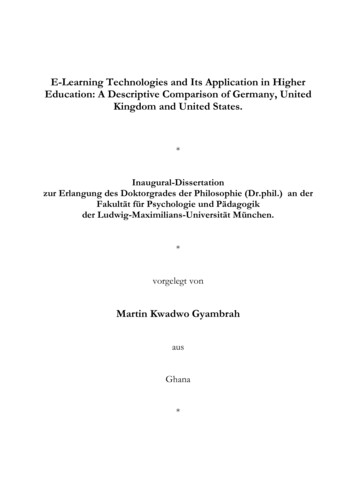
Transcription
E-Learning Technologies and Its Application in HigherEducation: A Descriptive Comparison of Germany, UnitedKingdom and United States.*Inaugural-Dissertationzur Erlangung des Doktorgrades der Philosophie (Dr.phil.) an derFakultät für Psychologie und Pädagogikder Ludwig-Maximilians-Universität München.*vorgelegt vonMartin Kwadwo GyambrahausGhana*
E-learning Technologies and its Application in Higher Education: A Descriptive Comparison of Germany, UK and USA.*Erstgutachter: Prof. Dr. Rudolf TippeltZweitgutachter: PD. Dr. Manuela PietraßDatum der mündlichen Prüfung: 25. June 2007*2
E-learning Technologies and its Application in Higher Education: A Descriptive Comparison of Germany, UK and USA.ACKNOWLEDGEMENTI will first of all thank the Almighty God for His strength in the preparation of this study.My sincere appreciation also goes to my supervisor, Prof. Dr. Rudolf Tippelt for his unparalleledguidance, support and coaching. I am indebted to Professors Manuela Pietrass and Frank Fischerfor all their assistance. I also express gratitude to Dr. Dr. Christian Werner for his advice andsupport. Further, I am deeply grateful to my parents Thomas Gyambrah and Jane Arkoh for alltheir assistance, advice and encouragement. Further my warm gratitude to my dear wife MiriamGyambrah, children Floriana and Felix for their support and perfect understanding. My heartfeltthanks also goes to the following experts without whose help the project will not have beensuccessful. Their names appear in alphabetical order and according to country.Dr. Birgit GaiserDr. Bernhard ErtlProf. Dr. Frank FischerProf. Dr. Henning PätzoldDr. Matthias NücklesProf. Dr. Manuela PietrassProf. Dr. Michael KerresDr. Thomas HülsmannProf. Dr. Thomas KöhlerProf. Dr. Theo BastiaensMr. Andreas MeisznerDr. David GrayProf. Don PasseyProf. Diana LaurillardProf. Gilly SalmonProf. Harvey MellarProf. Lawrence HamburgProf. Mike SharplesProf. Rosemary LuckinMr. Tony ChurchillGERMANY- Knowledge Media Research Center, Tübingen- Universität der Bundeswehr- University of Munich- Technical University, Kaiserslautern- University of Freiburg- University of Munich.- University of Duisburg-Essen- Carl von Ossietzky University of Oldenburg- Technische Universität, Dresden- FernUniversität in HagenUNITED KINGDOM (UK)- Open University- University of Surrey- Lancaster University- University of London- University of Leicester- University of London- The Higher Education Academy- University of Nottingham- University of London- University of LeicesterUNITED STATES OF AMERICA (USA)Prof. Anne M. Hoag- The Pennsylvania State UniversityMr. Brain Newberry- California State University, San Bernardino.Prof. Betty Hubschman- Florida International UniversityProf. David Whale- Central Michigan UniversityDr. Gary Bitter- Arizona State UniversityProf. Lauren Cifuentes- Texas A&M UniversityProf. Mike Rogers- University of GeorgiaProf. M. Wronkovich- Ashland University- Carnegie Mellon UniversityProf. Roger DannenbergProf. Theresa Franklin- Ohio University3
E-learning Technologies and its Application in Higher Education: A Descriptive Comparison of Germany, UK and USA.TABLE OF CONTENTSTITLE PAGE .0FIRST AND SECOND READER .1ACKNOWLEDGEMENT .2TABLE OF CONTENTS . . . . . . . . . . . . . . . . . . . . . . . . . . . . . . 3LIST OF TABLES AND FIGURES . . . . . . . . . . . . . . . . . . . . . . . . . . . . . . . . . . . 5ABSTRACT . . . . . . . . . . . . . . . . . . . . . . . 121. INTRODUCTION . . . . . . . . . . . . . . . . . . . . . . . . . . . . . . . .131.1.1. Today’s Knowledge Society 131.1.2. Knowledge Society and Digital Literacy .171.1.3. State of UK’s Higher Education .181.1.4. State of Germany’s Higher Education . . 191.1.5. State of USA’s Higher Education . .211.1.6. Summary: State Of Higher Education across the UK, Germany and USA .231.1.7. E-Learning: Context for Workforce Education in the Information Economy .251.1.8. What Is E-Learning?.251.1.9. E-Learning: Historical Background .261.1.10. Benefits of E-Learning . .271.1.11. E-Learning and Universities- Driving Forces . .291.1.12. Forms/Characteristics of E-Learning .311.1.13. How Is E-Learning Delivered?.321.1.14. How Is E-Learning Organized?.331.1.15. Technology Trends .351.1.16. What Kinds of Technologies Are Being Used?.361.1.17. New Organisational Arrangements in E-Learning .371.1.18. E-Learning and Quality Assurance .381.1.19. Emerging Policy Issues .432. THEORETICAL BACKGROUND . .452.1.1. Social Construction of Technology (SCOT) . .472.1.2. Social Shaping of Technology (SST) Theory .492.1.3. Educational Technology and Social Shaping Of Technology (SCOT) .512.1.4. Educational Technology – A New Orientation .532.1.5. Evolution of E-Learning .552.1.6. The Growing and Diversifying Demand for HE: Drivers and Trends . .582.1.7. The Policy Context .594
E-learning Technologies and its Application in Higher Education: A Descriptive Comparison of Germany, UK and USA.2.1.8. Structural Issues for Traditional Universities .652.1.9. E-Learning Technologies and Applications: E-Learning Models 672.1.10. Adoption, Diffusion and Exploitation of E-learning Technologies .712.1.11. E-Learning and Learning Processes 782.1.12. Pedagogical Approaches and Learning Theory . 812.1.13. Impact of E-Learning .932.1.14. E-Learning and International Knowledge Transfer .983. METHODOLOGY . .1003.1.1. Research Design .1003.1.2. Hypothesis 1023.1.3. Sample .1033.1.4. Grounded Theory .1053.1.5. Validation of Qualitative Results & Screen Shots of Maxqda2 .1064. ANALYSIS AND RESULTS . .1084.1.1. Review of Quantitative Reports-UK .1084.1.2. Review of Quantitative Reports- USA .1394.1.3. Review of Quantitative Data- Germany 1704.1.4. Quantitative Review: International Comparisons of Germany, UK and USA.1884.1.5. Summary Comparisons of National and International Quantitative Reports .1974.1.6. Qualitative Analysis and Results (Expert Interviews) 2015. DISCUSSION . .2495.1.1. Policy and Strategy .2515.1.2. E-Learning Technologies .2585.1.3. E-Learning Technology Applications 2595.1.4. Didactical/Pedagogical Approach(s) .2605.1.5. Impact and Limiting Factors .2635.1.6. Future Trends/ Scenarios .2675.1.7. Education Evolution Enabled By E-Learning . .2725.1.8. International knowledge transfer via e-learning . 2736. IMPLICATIONS OF STUDY . 2757. RECOMMENDATIONS FOR FURTHER RESEARCH . .2788. CONCLUSION . .2799. LIMITATIONS OF STUDY . .28010. REFERENCES . 28211. APPENDIX . .2915
E-learning Technologies and its Application in Higher Education: A Descriptive Comparison of Germany, UK and USA.LIST OF TABLESTable 1:Entry rates into higher education, 2003Table 2:Changes in higher education enrolments, 1995 to 2003Table 3:E-learning technologiesTable 4:Average number of course types offered per institutionTable 5:ILT use for Non-Schedule 2 coursesTable 6:Enablers and barriers to ICT developmentTable 7:Management of ChampionsTable 8:Uses of the LAN/ Intranet by StaffTable 9:ILT Expenditure for the FE sector 2001/2002 ( millions)Table 10:VLEs in useTable 11:Nature of plans for future development of processes to support e-learningTable 12:Institutional strategies informing e-learning developmentTable 13:External strategies informing e-learning developmentTable 14:Modules/units of study in VLE(s) characteristicsTable 15:Driving factors for environments and processes that support e-learningTable 16:Whether virtual learning environments are usedTable 17:Which VLE(s) are used?Table 18:Mobile technologies to connect to VLETable 19:Uses made of VLE(s)Table 20:Subject areas/departments using VLE(s)Table 21:Barriers to development of processes to support e-learningTable 22:Percent of 2-year and 4-year Title IV degree-granting institutions offering distanceeducation courses in 2000–2001Table 23:Number and percentage distribution of 2-year and 4-year Title IV degree-grantinginstitutions, by distance education program status and institutional type and sizeTable 24:Total number of 2-year and 4-year Title IV degree-granting institutions, and thenumber and percent of institutions that offered distance education courses, bylevel of institutional offerings: 2000–2001Table 25:Number of 2-year and 4-year Title IV degree-granting institutions that offereddistance education courses, total enrolment in all distance education courses, andenrolment in college-level, credit-granting distance education courses, byinstitutional type and size.6
E-learning Technologies and its Application in Higher Education: A Descriptive Comparison of Germany, UK and USA.Table 26:Number of 2-year and 4-year Title IV degree-granting institutions that offereddistance education courses, total number of different distance education courses,and the number of different college-level, credit-granting distance educationcourses, by institutional type and size: 2000–2001.Table 27:Percentage distribution of 2-year and 4-year Title IV degree-granting institutionsoffering distance education courses, by the number of distance education coursesoffered and type of course: 2000–2001.Table 28:Percent of 2-year and 4-year Title IV degree-granting institutions offering anydistance education courses, by primary technology for instructional delivery fordistance education courses, and by institutional type and size: 2000–2001Table 29:Percentage distribution of 2-year and 4-year Title IV degree-granting institutionsthat offered distance education courses in 2000–2001 or planned to offer distanceeducation in the next 3 yearsTable 30:Percent of 2-year and 4-year Title IV degree-granting institutions that planned tostart or increase their use of various technologies: 2002Table 31:Online education is critical to long-term strategyTable 32:Does your school offer online programs for a degree?Table 33:What Types of Courses are offered?Table 34:Comparing Face-To-Face and Learning Outcomes in Online EducationTable 35:Students Taking at Least One Online Course: Fall 2002 and projected Fall 2003Table 36:Learning Outcomes in Online Education are currentlyTable 37:Number of students taking at least one online courseTable 38:Enrolment Fall 2003 to Fall 2004Table 39:Online Education is Critical to Long-Term Strategy: 2003, 2004, and 2005Table 40:It is More Difficult to Evaluate the Quality of an Online Course - Fall 2004Table 41:Number of Students Taking at Least One Online CourseTable 42:Online Course Penetration - Fall 2004Table 43:Online Program Penetration - Fall 2004-Table 44:Online Penetration by Program Discipline - Fall 2003Table 45:Details Of National Policy Aimed at Enhancing the Digital EconomyTable 46:Details Of National Policy Aimed at Enhancing Education and TrainingTable 47:Economist Intelligence Unit e-readiness rankings, 2005Table 48:Details of Broadband Penetration among the G7 CountriesTable 49:Broadband Statistics among the Three CountriesTable 50:OECD Broadband Statistics7
E-learning Technologies and its Application in Higher Education: A Descriptive Comparison of Germany, UK and USA.Table 51:Relative Provision of Distance Learning In the US and Its Main CompetitorsTable 52:Comparisons of Policy and StrategyTable 53:Comparison of E-learning Technologies and ApplicationsTable 54:Comparison of Pedagogical/Didactical ApproachesTable 55:Comparison of Impact of E-learningTable 56:Comparison of Limiting FactorsTable 57:What is e-learning? – GermanyTable 58:What is e-learning?-UKTable 59:What is e-learning?-USATable 60:Forms of e-learning products-GermanyTable 61:Forms of e-learning products- UKTable 62:Forms of e-learning products-USATable 63:Content of e-learning programs- GermanyTable 64:Content of e-learning programs-UKTable 65:Content of e-learning programs-USATable 66:Orientation to local or international markets-GermanyTable 67:Orientation to local or international markets- UKTable 68:Orientation to local or international markets-USATable 69:Main philosophy or strategy-GermanyTable 70:Main philosophy or strategy-UKTable 71:Main philosophy or strategy- USATable 72:Current emerging trends-GermanyTable 73:Current emerging trends-UKTable 74:Current emerging trends-USATable 75:Comparisons of what is e-learning-Germany, UK and USATable 76:Comparisons of e-learning products-Germany, UK and USATable 77:Comparisons of content of e-learning programs-Germany, UK and USATable 78:Comparisons of orientation to local or international- Germany, UK and USATable 79:Comparisons of Main philosophy for e-learning- Germany, UK and USATable 80:Comparisons of Current emerging trends- Germany, UK and USATable 81:Prevalent e-learning technologies/tools- GermanyTable 82:Prevalent e-learning technologies/tools-UKTable 83:Prevalent e-learning technologies/tools-USATable 84:Comparisons of prevalent e-learning technologies- Germany, UK and USATable 85:Specific ways technologies /tools are applied- Germany8
E-learning Technologies and its Application in Higher Education: A Descriptive Comparison of Germany, UK and USA.Table 86:Specific ways technologies /tools are applied-UKTable 87:Specific ways technologies /tools are applied-USATable 88:Comparisons of applications of e-learning technologies- Germany, UK and USATable 89:Didactical/pedagogical approach(s)/uniformity – GermanyTable 90:Didactical/pedagogical approach(s)/uniformity-UKTable 91:Didactical/pedagogical approach(s)/uniformity-USATable 92:Fit to educational philosophies of other countries- GermanyTable 93:Fit to educational philosophies of other countries-UKTable 94:Fit to educational philosophies of other countries-USATable 95:Comparisons of didactical approaches- Germany, UK and USATable 96:Comparisons of fit to other educational philosophies- Germany, UK andTable 97:Impact- GermanyTable 98:Impact –UKTable 99:Impact-USATable 100:Limiting factors- GermanyTable 101:Limiting factors –UKTable 102:Limiting factors –USATable 103:Comparisons of impact- Germany, UK and USATable 104:Comparisons of limiting factors- Germany, UK and USATable 105:Technologies anticipated in the next 5 years- GermanyTable 106:Technologies anticipated in the next 5 years-UKTable 107:Technologies anticipated in the next 5 years-USATable 108:Trend of technology applications in the next 5 years- GermanyTable 109:Trend of technology applications in the next 5 years-UKTable 110:Trend of technology applications in the next 5 years-USATable 111:Anticipated impact of e-learning in the next 5 years- GermanyTable 112:Anticipated impact of e-learning in the next 5 years-UKTable 113:Anticipated impact of e-learning in the next 5 years-USATable 114:Strategic options for overcoming obstacles in the next 5 years- GermanyTable 115:Strategic options for overcoming obstacles in the next 5 years-UKTable 116:Strategic options for overcoming obstacles in the next 5 years-USATable 117:Future scenarios for e-learning in the next 5 years- GermanyTable 118:Future scenarios for e-learning in the next 5 years-UKTable 119:Future scenarios for e-learning in the next 5 years-USATable 120:Implications for international knowledge transfer- GermanyUSA9
E-learning Technologies and its Application in Higher Education: A Descriptive Comparison of Germany, UK and USA.Table 121:Implications for international knowledge transfer-UKTable 122:Implications for international knowledge transfer-USATable 123:Comparisons of anticipated technologies i- Germany, UK and USATable 124:Comparisons of trend of applications (next 5 years) - Germany, UK and USATable 125:Comparisons of anticipated impact (next 5 years) - Germany, UK and USATable 126:Comparisons of strategies for overcoming obstacles (next 5 years) - Germany, UKand USATable 127:Comparisons of future scenarios in the next 5 years- Germany, UK andUSATable 128:Comparisons of implications for international knowledge transfer- Germany, UKand USALIST OF FIGURESFigure 1-The Demand Driven Learning Model (DDLM)Figure 2:Organisational Absorptive Capacity for E-learning ModelFigure 3:CSALT Networked Learning ModelFigure 4:ICT expenditure per studentFigure 5:Staff Development Expenditure per member of teaching staffFigure 6:Resources in most need of developmentFigure 7:Virtual Learning Environments: market leadersFigure 8:The key tasks of ILT ChampionsFigure 9:Most commonly cited VLEs in useFigure 10:Teaching and Learning uses of LANFigure 11:College learning platformsFigure 12:Use of college learning platformsFigure 13:The use of electronic communicationsFigure 14:Application of ILT in mainstream programmesFigure 15:College approach to ICTFigure 16:Use of ICT in all or most mainstream college programmesFigure17:College learning platformsFigure 18:Email and other e-communications described as “common practice”Figure 19:Use of college learning platformsFigure 20:Total use of ICT in student inductionFigure 21:Online assessment activitiesFigure 22:Prevalence of MeasuresFigure 23:State Activities to Promote Access10
E-learning Technologies and its Application in Higher Education: A Descriptive Comparison of Germany, UK and USA.Figure 24:State Activities to Promote QualityFigure 25:Percent of 2-year and 4-year Title IV degree-granting institutions offering distanceeducation courses in 2000–2001Figure 26:Percentage distribution of 2-year and 4-year Title IV degree-granting institutions,by distance education program status: 2000–2001Figure 27:Percentage distribution of enrolment in college -level, credit-granting distanceeducation courses in 2-year and 4-year Title IV degree-granting institutions, bylevel of course offerings: 2000–2001Figure 28.Percentage distribution of enrolment in all distance education courses in 2-yearand 4-year Title IV degree-granting institutions, by institutional type: 2000–2001Figure 29.Percentage distribution of 2-year and 4-year Title IV degree-granting institutionsoffering distance education courses, by the number of distance education coursesoffered and type of distance education course: 2000–2001Figure 30:Institutions that offer online coursesFigure 31:Types of Offerings-All SchoolsFigure 32:Learning Outcomes online education todayFigure 33:Learning OutcomesFigure 34:Strategy of online learning: Number of online students fall 2003Figure 35:Offer Online CoursesFigure 36:Online Education is Critical to Long-Term StrategyFigure 37:Learning OutcomesFigure 38:Enrollment Fall 2003 to fall 2004Figure 39:State distribution of project partners and students by numberFigure 40:Types of Institutions of Higher Learning among Project PartnersFigure 41:Project partner task areasFigure 42:Product rangeFigure 43:Target groupsFigure 44:Disciplinary groupsFigure 45:Instructional ScenariosFigure 46:Instructional MethodFigure 47:Multimedia usage formsFigure 48:Telemedia ApplicationsFigure 49:Product distribution by disciplinary groupFigure 50:Product typesFigure 51:International Product Range11
E-learning Technologies and its Application in Higher Education: A Descriptive Comparison of Germany, UK and USA.Figure 52:Project Partner GoalsFigure 53:(Partial-) virtualized instructional formsFigure 54:(Partial-) virtualized instructional forms according to disciplinary groupsFigure 55:Social forms by disciplinary groupFigure 56:Use of instructional concepts by disciplinary groupFigure 57:Multimedia usage formsFigure 58:Telemedia applicationsFigure 59:New media usageFigure 60:FlexibilizationFigure 61:Details of networked readiness of Germany, UK and USAFigure 62:Details of PCs per 100 inhabitants across the three countriesFigure 63:Details of DSL Subscriber lines as at 2001Figure 64:Gives Details of Mobile Communications Users as At 2001Figure 65:Details of Broadband Penetration among the G7 CountriesFigure 66:Gives Details of Broadband Penetration Per CapitaFigure 67:OECD Broadband Subscribers per 100 inhabitantsFigure 68:Details of ICT Expenditure per Capita, 2002, In EurosFigure 69:Comparison of Distance-Learning Providers in the US and Its Main CompetitorsFigure 70:Model of Education Evolution12
E-learning Technologies and its Application in Higher Education: A Descriptive Comparison of Germany, UK and USA.ABSRACTThere is a general agreement that we have entered the information economy, that highereducation is a critical element in this knowledge society. This has placed a new demand on itsteaching and research functions, with growing emphasis on lifelong learning and more flexibleforms of higher education delivery. Notwithstanding, there is also a widespread scepticism as towhether educational systems will be able to overcome their traditional inertia and respond to thechallenge of the knowledge-based revolution.Currently the prominence of ICT and other external influencing factors; economic, social,cultural and the changing role of governmental policy are driving the inner life of the highereducation sector. In that respect many higher educational institutions are turning to e-learningtechnologies for improving the quality of learning by means of access to resources, services, longdistance collaborations and exchanges. However this transition has been characterized by a mixedsense of optimism, skeptism and a lack of “adequate benchmarks”.It is within this background that this explorative study sought to carry out a descriptivecomparison between Germany, UK and the USA with the objective of identifying the currenttrends, establishing tendencies of differences or similarities and identifying future trends (next 5years) across the three countries. This is directed at synthesising “best practices” which couldfacilitate international knowledge transfer and the future development of e-learning. In pursuanceof these aims the study employed the use of both quantitative and qualitative data sources. Inobtaining the quantitative data, national and international reports that detail out the activities ofe-learning in higher educational institutions across the three countries were reviewed and relevantdata filtered. Further explanations, clarifications as well as predictions of future trends weresought through expert interviews (n 30 experts).The findings indicate that: 1) The three countries did not exhibit much differences interms of policy however they exhibited differences in terms of strategy and tactics in e-learning.2) The three countries exhibited differences in terms of the prevalent e-learning technologiesused as well as the application of such technologies. 3) In terms of didactical approaches andorientation to either local or international markets the three countries exhibited differences iv) Interms of impact and limiting factors the three countries exhibited differences in scale andproportion though qualitative impact was difficult to estimate. 5) In terms of future trends orscenarios different projections were made across the three countries.The implications of the findings are discussed and recommendations offered for furtherresearch.13
E-learning Technologies and its Application in Higher Education: A Descriptive Comparison of Germany, UK and USA.E-Learning Technologies and its Application in Higher Education:A Descriptive Comparison of Germany, United States and United Kingdom.CHAPTER- 1INTRODUCTIONThe application of Information and Communication Technologies(ICTs) have become soattached to contemporary educational delivery worldwide that it has virtually become impossibleto deliver or receive formal education without the application of such advanced technologies inthe processes. The all encompassing term -ICT- which covers a wide range of technologies forgathering, storing, retrieving, processing, analysing and transmitting or presenting information is,in reality, practically indispensable in the delivery of contemporary education. Consequently,governments and its agencies, the corporate sector, educational outfits and individualsincreasingly continue to investment huge sums of capital, time and other resources in thispowerful engine of growth to keep up-to-date with regard to the current demands and trends.In line with this fact, higher educational establishments in particular have dramaticallytransformed their mode of operation. Today, the use of chalk and duster in our seminar roomsand lecture theatres are completely extinct on some campuses. In place of that, we now haveinteractive whiteboards powered by computers and projectors, learning management systems etc.Electronic learning mediums referred to as e-learning is increasingly becoming the establishedpractice with a wide array of positive outcomes. In this vein my introductory chapter will examinetoday’s knowledge society, the state of higher education in the UK, Germany and United States,e-learning as a current context for workforce education, what e-learning is, the historicalbackground of e-learning, its benefits, the driving forces behind e-learning, the forms of elearning, characteristics of e-learning, how it is delivered and organized, technology trends, thekinds of technologies being used, new organisational arrangements in e-learning, qualityassurance and emerging policy issues.1. TODAY’S KNOWLEDGE SOCIETYIn today’s knowledge society it has become an established fact that the role of knowledgein socio- economic development is certainly not new. In the knowledge era, competitiveadvantage and human development will depend only on access to knowledge at the local,national, regional and global levels. This has been evidently described and anticipated by a Frencheconomist,“Each student will be competing with other students throughout the world withsimilar skills, but also the efficiency of the universities will be a major factor in a country’s14
E-learning Technologies and its Application in Higher Education: A Descriptive Comparison of Germany, UK and USA.competitiveness. In other words, German universities [will be] competing less among themselvesthan with Japanese or American universities.”(Lesourne, 1988)However, knowledge has taken on an even greater degree of relevance and a different shape withthe advent and deepening of the knowledge economy and society. There are multiple drivers ofthis phenomenon, one of them being the way in which society is becoming more complex andunpredictable in both positive and challenging ways. One can point to globalization, theeconomic value of ideas, global scale economic activities and rapid development in science andtechnology, including information and communications technologies (ICTs), as examples of thischange. (UNDESA/DPADM, 2003).Consequently, these new challenges place a new and constant demand on the nations ofthe world for responses that is more creative, innovative, smarter, and more active in their use ofknowledge. Yet, while we often have an abundance of information, there is equally often apronounced deficit of knowledge, or at least a deficit in our ability to create, use and apply itmeaningfully (DPADM, 2003).On the other hand the accepted fact that we now live in aninformation age labeled the “information society” appears to some, including myself, asinsufficient to describe the phenomenal transformations that characterize our times (Vigilante,June 2003). In its Human Development Report of 2001, the UNDP emphasized that “theinformation age is an input and not the outcome along the road towards the transition to aknowledge society”. The knowledge society is the society that knows how to use information.Boisot (1998) notes that knowledge assets are manifested in terms of technologies, competencesand capabilities. Technology is defined as “socio-physical systems configured so as to producecertain specific types of physical effects.” Key among the attributes of this society is thecharacteristic of being networked. And in today’s globalize world networks define our lives andmodes of production. In the industrial age, businesses and organizations were verticallyintegrated. Today, horizontal networks predominate. Production is increasingly organized amongseparate players and their complex interactions create the value chain that drives the technologybased global economy. Global networks cover many areas of activities, for instance, scientificresearch and innovation, production, E-business, E-education etc.According to Manuel Castells’ (2000), who is probably the most lucid analyst of theseglobal socio-technological transformations “networks create a global economy and a globalwealth of knowledge that are interdependent, asymmetrical, and diversified. This is done with anextraordinarily variable geometry that tends to dissolve historic, economic and geographicfactors”. An experienced sailor can navigate a wild sea. But in the case of the
EE--l leea ar rn niing g TTeecchhnooloogi ieess and d it tss A Apppplic catioon in HHighheer EEduucatioon:: A DDeesscripptivvee CCoom mpparissoon ooff GGeermanyy,, UUKK and UUSSA. 3 ACKNOWLEDGEMENT I will first of all thank the Almighty God for His strength in the preparation of this study. My sincere appreciation also goes to my supervisor, Prof. Dr. Rudolf Tippelt for his unparalleled
